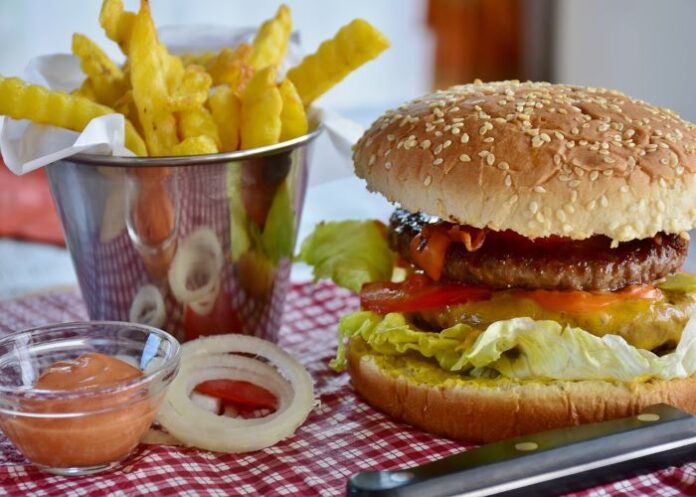Researchers have warned that billions of nanoparticles found in additives in junk food reach infants in the womb, probably changing their gut microbiome and damaging gut cells, thus raising their allergy risk.
The finding – based on a review of around 170 studies – may partly explain why allergy rates have rocketed in the US and Britain over the past two decades.
The scientists discovered that the tiny particles added to sugars, sweeteners and preservatives used in the making of sweets, cakes and syrups, can cross the placenta and reach the foetus. These accumulate in the gut and disrupt the babies' microbiome, they say.
Mountains of research show that high-fat diets during pregnancy can wreck babies' immune systems and leave them prone to a host of health issues. A total of 5.6m American schoolchildren have allergies, rates in the US having doubled in about a decade, rising from 2% in 2007 to 7% today. Britain has seen a similar rise, reports the Daily Mail.
Scientists believe the surge is because children are growing up in an increasingly sterile world, free of many germs that help build a robust immune system.
In the latest research, the team combed through databases for studies on the effect of additives in food on the body’s bacteria and immune system.
A total of 168 research papers were extracted, including studies carried out in the lab, on rodents and in humans. They focused on three additives found in many processed foods – including titanium dioxide, which is used in popular candies, salad dressing and chewing gum to give a smooth texture or to work as a white colourant.
The study also looked at silicon dioxide, which stops foods from caking or sticking together, and nanosilver, a preservative used in food packaging to extend the shelf-life of snacks.
The scientists found lots of evidence that, in mice, nanoparticles found in these additives can cross the placenta and enter the babies’ gut. But they said there were also some signs this can happen in humans, too.
The gut does not absorb the tiny particles; instead, they clump together and disrupt the surrounding bacteria.
Because the microbiome is so connected to the immune system, the researchers theorise it could be playing a role in the development of allergies. And because allergies in children are more common than in adults, they said this boosts their theory. The review article was published in Frontiers in Allergy.
Dr Karine Adel-Patient, a human health expert at Université Paris-Saclay, warned: “The impact of such exposure on the development of food allergy has not been assessed to date.
“Our review highlights the urgent need for researchers to assess the risk related to exposure to food-borne inorganic nanoparticles during a critical window of susceptibility and its impact on children’s health. Such agents can cross the placental barrier and then reach the developing foetus. Excretion in milk is also suggested, continuing to expose the neonate.”
Peanuts and tree nuts are behind most allergies in children, whereas in the general population shellfish, milk and peanuts were the main cause of allergies.
More than 900 food products include at least one additive or component that is defined as a nanoparticle.
The most common sub-sectors are infant formula (26%), confectionery (16%), breakfast cereals (15%), cereal bars (13%) and frozen pastries and desserts (11%).
Study details
Perinatal exposure to foodborne inorganic nanoparticles: A role in the susceptibility to food allergy?
Mohammad Issa, Gilles Rivière, Eric Houdeau, and Karine Adel-Patient
Published in Frontiers in Allergy on 5 December 2022
Abstract
Food allergy (FA) is an inappropriate immune response against dietary antigens. Various environmental factors during perinatal life may alter the establishment of intestinal homeostasis, thereby predisposing individuals to the development of such immune-related diseases. Among these factors, recent studies have emphasised the chronic dietary exposure of the mother to foodborne inorganic nanoparticles (NP) such as nano-sized silicon dioxide (SiO2), titanium dioxide (TiO2) or silver (Ag). Indeed, there is growing evidence that these inorganic agents, used as food additives in various products, as processing aids during food manufacturing or in food contact materials, can cross the placental barrier and reach the developing foetus. Excretion in milk is also suggested, hence continuing to expose the neonate during a critical window of susceptibility. Due to their immunotoxical and biocidal properties, such exposure may disrupt the host-intestinal microbiota's beneficial exchanges and may interfere with intestinal barrier and gut-associated immune system development in foetuses then the neonates. The resulting dysregulated intestinal homeostasis in the infant may significantly impede the induction of oral tolerance, a crucial process of immune unresponsiveness to food antigens. The current review focuses on the possible impacts of perinatal exposure to foodborne NP during pregnancy and early life on the susceptibility to developing FA.
See more from MedicalBrief archives:
‘Junk’ plant-based diets pose health risks
Babies’ gut bacteria affected by birth delivery method
Breastfeeding and risks of allergies and asthma
Oral immunotherapy to induce peanut allergy remission in young children – IMPACT trial

